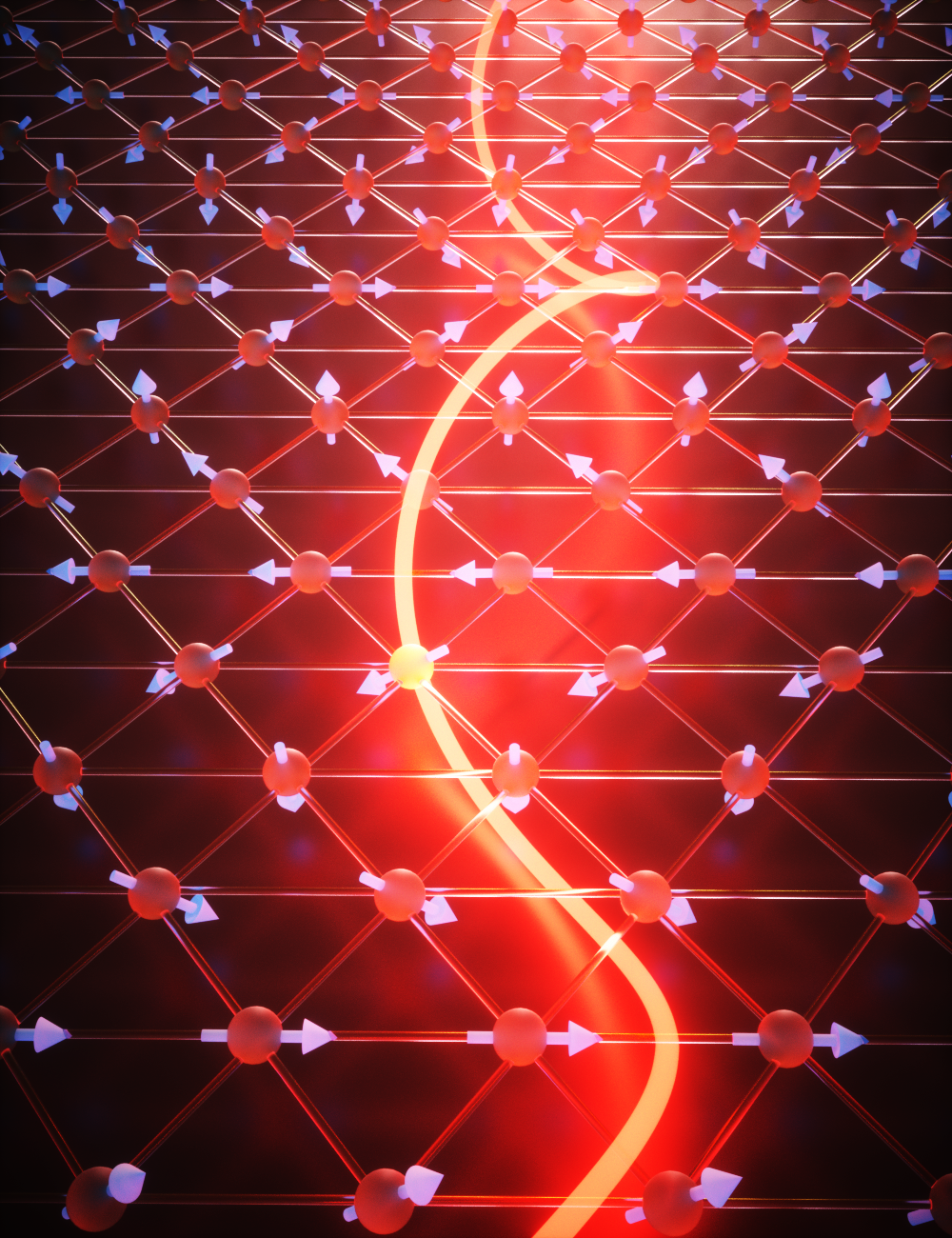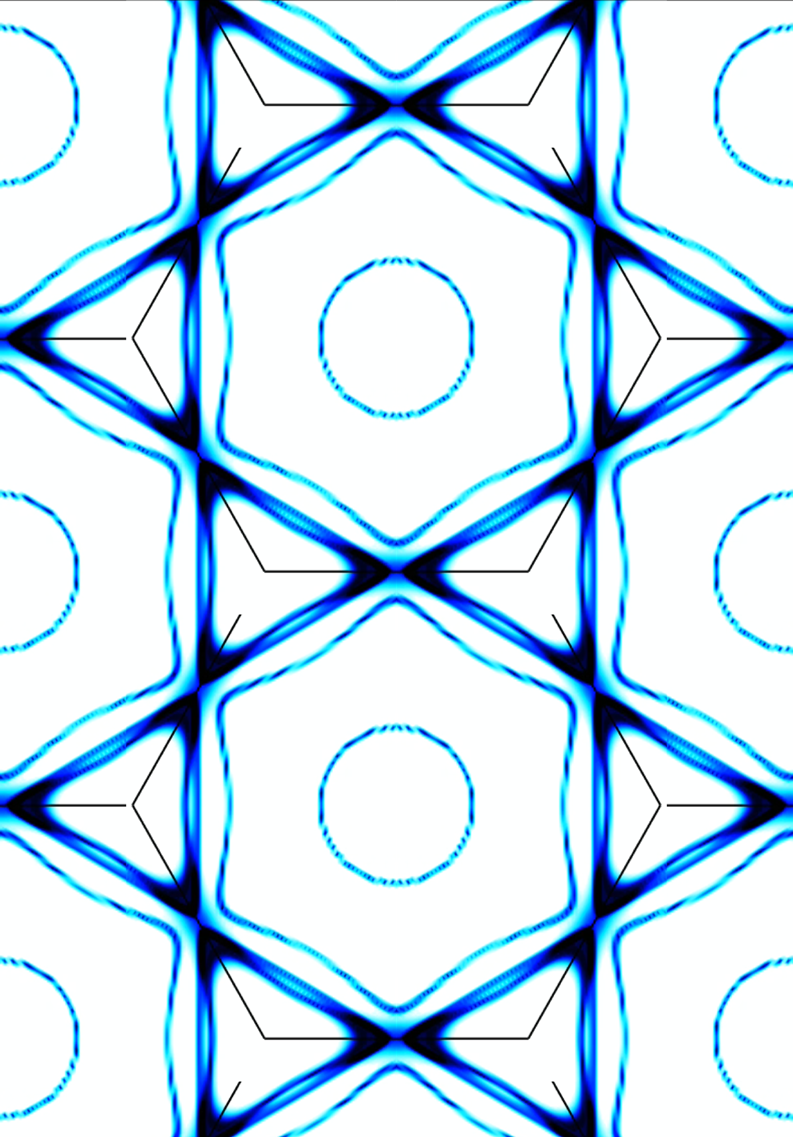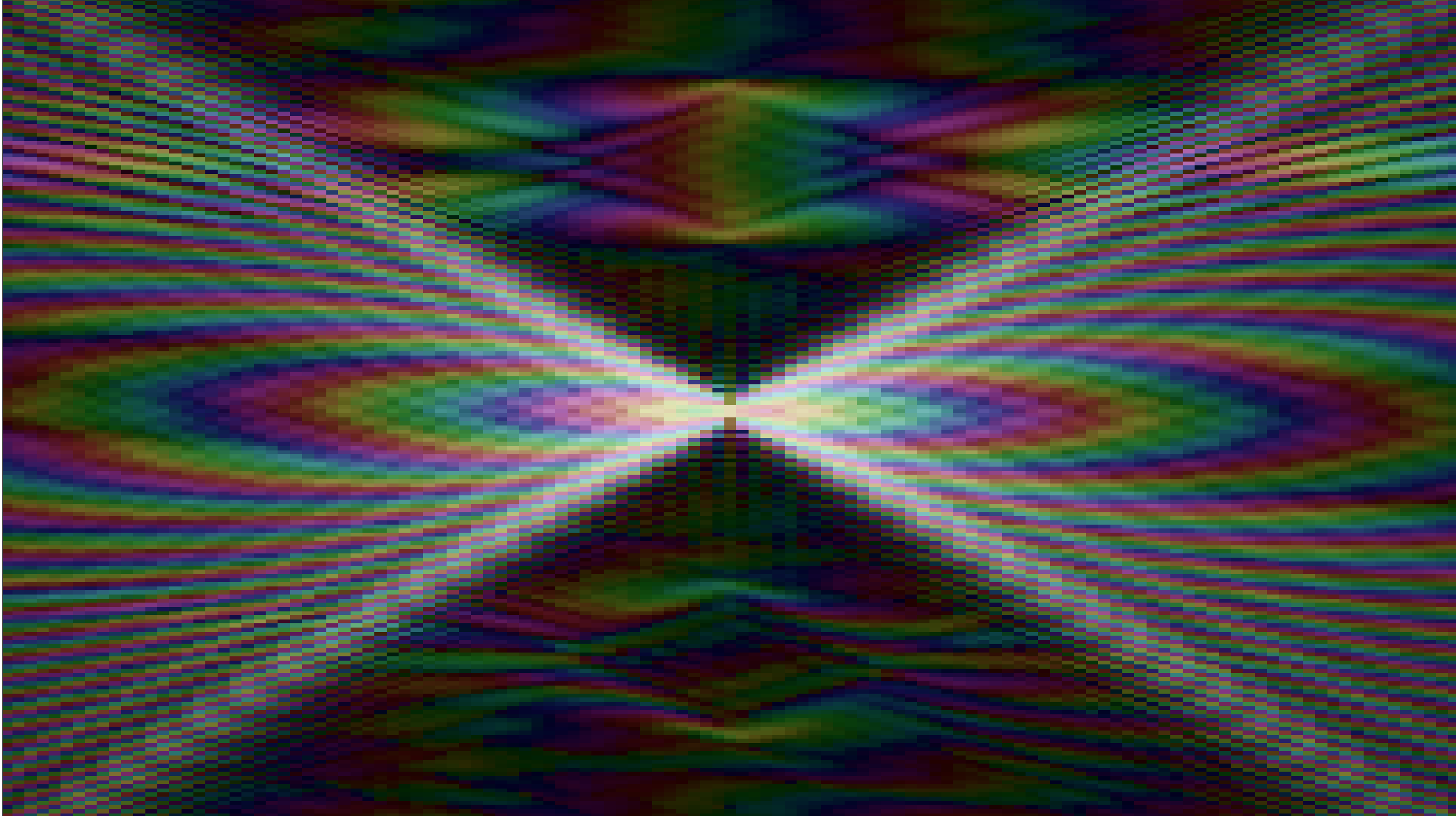
Flat bands in a 3D line graph lattice
Fermi pockets
in a kagome superconductor
Electronic singularities
in a kagome metal
A single-layer
multiferroic
Structured
illumination
X-ray
holography
2D diamond
Randomized
Probe Imaging
Flat bands in the
2D kagome lattice
Friedel oscillations
and density-waves
in cuprates
Magnetic fractals
in complex oxides
Topological Dirac fermions in the 2D kagome network
Electrical switching of a p-wave magnet
 Altermagnets (ALMs) are a recently discovered class of magnetic materials that, like ferromagnets, exhibit spin splitting and spin-momentum locking without relying on spin–orbit coupling (SOC), yet also like antiferromagnets, have compensated magnetic moments. Recent theoretical studies have shown that non-collinear spiral magnetic order can exhibit sizable odd-parity (p-wave) spin polarization even in the absence of SOC. An important characteristic of such odd-parity spin polarization is that the inversion operation reverses the spin texture, suggesting the possibility of electrical and nonvolatile control of the non-relativistic spin polarization if the material is also ferroelectric.
Altermagnets (ALMs) are a recently discovered class of magnetic materials that, like ferromagnets, exhibit spin splitting and spin-momentum locking without relying on spin–orbit coupling (SOC), yet also like antiferromagnets, have compensated magnetic moments. Recent theoretical studies have shown that non-collinear spiral magnetic order can exhibit sizable odd-parity (p-wave) spin polarization even in the absence of SOC. An important characteristic of such odd-parity spin polarization is that the inversion operation reverses the spin texture, suggesting the possibility of electrical and nonvolatile control of the non-relativistic spin polarization if the material is also ferroelectric.
In our latest work, we demonstrated the electrical switching of p-wave magnetism in van der Waals spin spiral (type-II) multiferroic NiI2. From spin-group symmetry analysis and first-principles calculations, we found that this chiral magnetic order exhibits p-wave magnetism with non-relativistic spin splitting rigidly connected to the ferroelectric polarization. We performed bulk photovoltaic effect and circular photogalvanic effect measurements to characterize the polar order and odd-parity spin polarization, respectively. Our results revealed rigid coupling between non-relativistic spin polarization and spin chirality, which can be electrically controlled via improper ferroelectric polarization. Our work represents the first observation of an electrically switchable p-wave magnet.
See also Q. Song, et al., Electrical Switching of a p-wave magnet, Nature 642, 64 (2025)
In the news: MIT News
Flat bands in a 3D line-graph lattice
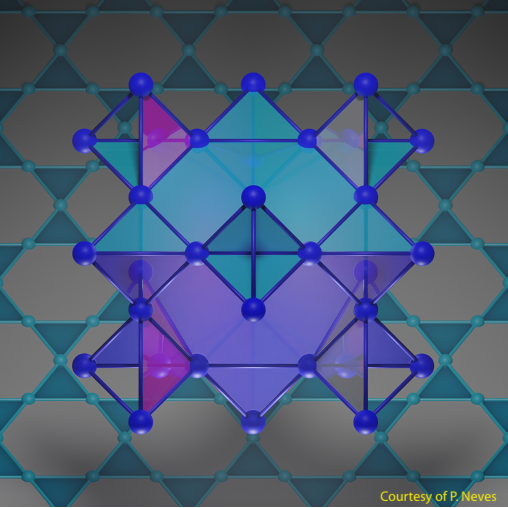 Flat band materials have emerged as an important class of quantum materials over the past few years: The flat band system not only enhances the electron-electron interaction effect but also maximizes the quantum geometric effect, promising the realization of novel emergent phases of matter such as fractional quantum anomalous Hall effect at zero field and quantum geometry-enabled unconventional superconductors. While flat band materials have been realized and extensively studied in two-dimensional (2D) platforms, including Moiré superlattices and geometrically frustrated kagome lattices, it remains an open question whether such a flat band can be realized in three-dimension (3D), with a potential to host new flat band phenomena inaccessible in lower dimensions.
Flat band materials have emerged as an important class of quantum materials over the past few years: The flat band system not only enhances the electron-electron interaction effect but also maximizes the quantum geometric effect, promising the realization of novel emergent phases of matter such as fractional quantum anomalous Hall effect at zero field and quantum geometry-enabled unconventional superconductors. While flat band materials have been realized and extensively studied in two-dimensional (2D) platforms, including Moiré superlattices and geometrically frustrated kagome lattices, it remains an open question whether such a flat band can be realized in three-dimension (3D), with a potential to host new flat band phenomena inaccessible in lower dimensions.
In our latest work (collaboration with Checkelsky lab), we developed the very first 3D flat band material, CaNi2, using a geometrically frustrated pyrochlore lattice. Our comprehensive VUV- and soft-X-ray ARPES investigations across the complete 3D Brillouin zone have unambiguously confirmed the realization of 3D flat bands in this system as well as the signature of nontrivial topology within the flat band. By chemical doping the 3D flat band toward the Fermi level, we have further discovered the emergence of superconductivity in pyrochlore metals, with a critical temperature of Tc = 6.2 K significantly higher than that observed in any 2D flat band materials to date. Our study not only expands the horizon of flat band materials to a new dimension but also opens a novel perspective for realizing exotic quantum phenomena at higher temperatures using a 3D flat band system. Figure from P. Neves.
See also J. Wakefield, M. Kang, P. Neves, D. Oh, et al., Three-dimensional flat bands in pyrochlore metal CaNi2, Nature 623, 301 (2023)
In the news: MIT News; Physics World; ALS Science Highlights
Fermi pockets in a kagome superconductor
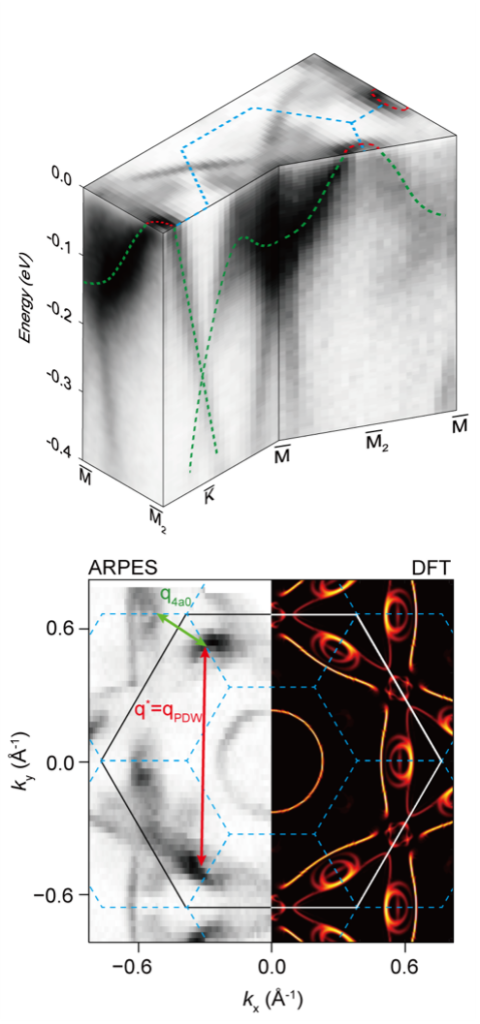 In recent years, novel emergent phenomena in the frustrated kagome lattices originating from their unique electronic band structure have been extensively explored. Representatively, vanadium-based kagome superconductors AV3Sb5 (A = K, Rb, Cs) attract much attention due to their cascade of correlated and topological electronic orders. Diverse experimental techniques have reported that time-reversal symmetry breaking, uniaxial charge stripes, nematicity, chiral electronic order, and pair density wave states in the charge ordered phase of AV3Sb5. However, their microscopic origin is not yet well established.
In recent years, novel emergent phenomena in the frustrated kagome lattices originating from their unique electronic band structure have been extensively explored. Representatively, vanadium-based kagome superconductors AV3Sb5 (A = K, Rb, Cs) attract much attention due to their cascade of correlated and topological electronic orders. Diverse experimental techniques have reported that time-reversal symmetry breaking, uniaxial charge stripes, nematicity, chiral electronic order, and pair density wave states in the charge ordered phase of AV3Sb5. However, their microscopic origin is not yet well established.
In our angle-resolved photoemission spectroscopy study, we directly visualize the formation of small hole pockets at the Fermi surface induced by 22 in-plane charge density modulation. In addition, by combining ARPES and spectroscopic-imaging scanning tunneling microscopy (SI-STM), we discovered wave vector q* that connect the two next nearest neighboring Fermi pockets in the first Brillouin zone (red arrow) in the non-superconducting state, which is consistent with the previously reported Cooper pair density wave vector qPDW in the superconducting state. We further demonstrate the renormalization of the q* in the presence of uniaxial charge stripe order. These observations imply that small hole fermi pockets are intimately correlated with charge stripes and pair density wave and provide an insight to the understanding of microscopic mechanism of a cascade of electronic orders in the novel quantum materials.
See also H. Li, D. Oh, M. Kang, et al., Small Fermi Pockets Intertwined with Charge Stripes and Pair Density Wave Order in a Kagome Superconductor, Physical Review X 13, 031030 (2023)
Realization of a single-layer van der Waals multiferroic
We searched for signatures of type-II multiferroic order in ultrathin van der Waals materials, to determine if such a state, comprising coexisting electrical polarization and spin order with strong magnetoelectric effects, could persist down to a single-atomic layer. We reported the first observation of such a state in triangular lattice material NiI2. This system has a layered structure and built-in magnetic frustration that promotes a complex magnetic ground state with proper-screw spin helices. The spin helix pattern breaks inversion symmetry and induces electrical polarization via magnetoelectric coupling. We use circular dichroic Raman measurements to directly probe the magneto-chiral ground state and its electromagnon modes originating from dynamic magnetoelectric coupling. Using birefringence and second-harmonic generation measurements, we detect a highly anisotropic electronic state simultaneously breaking three-fold rotational and inversion symmetry. The evolution of the optical signatures as a function of temperature and layer number surprisingly revealed a multiferroic state that persists down to the ultrathin limit of monolayer NiI2. These observations establish NiI2 and transition metal dihalides as a new platform for studying emergent multiferroic phenomena, chiral magnetic textures and ferroelectricity in the 2D limit.
See also Q. Song, C. A. Occhialini et al. Experimental realization of a single-layer multiferroic, Nature 602, 601 (2022)
In the news: MIT News; IEEE Spectrum
Quantum singularity in a topological kagome superconductor
The realization of novel collective phenomena and new quasiparticles represents a frontier of condensed matter research. Harnessing such properties of quantum materials may lead to the birth of next-generation technologies such as spintronics and quantum computing. A key pathway to realize new topological or strongly correlated phenomena often relies on the ‘quantum electronic singularities’ in material, which arises from a certain symmetry constraint of the lattice. In late 2020, a new series of kagome lattice compound AV3Sb5 (A = K, Rb, Cs) is discovered with a range of novel collective electronic phases – charge/stripe order, orbital flux phases, and superconductivity – receiving considerable attention from the condensed matter physics community. In our recent angle-resolved photoemission spectroscopy study, we elucidate the driving mechanism of collective phenomena in the AV3Sb5 series by revealing multiple quantum singularities (called van Hove singularities) near its Fermi level. These electronic singularities in AV3Sb5 emerge from the underlying kagome lattice symmetry and provide an essential source of strong correlation in the system. Intriguingly, the observed van Hove singularities in AV3Sb5 are characterized by two distinct flavours (p-type and m-type) owing to an intrinsic particle-hole asymmetry of the kagome lattice. These twofold singularity flavours have a profound implication on the unconventional behavior of charge order and superconductivity observed in the AV3Sb5 series. Our results establish the framework to understand the unconventional many-body phases in topological kagome metals based on the unique van Hove singularity physics of the kagome lattice.
See also M. Kang et al. Twofold van Hove singularity and origin of charge order in topological kagome superconductor CsV3Sb5, Nature Physics 18, 301 (2022)
In the news: MIT News; Berkeley Lab Science Snapshot
Maskless Fourier Transform Holography
Fourier Transform Holography (FTH) is widely utilized as an off-axis X-ray holography scheme. Then, a simple Fourier transform of the far-field interference pattern delivers the complex exit-wave function. In FTH, an integrated absorptive mask that contains a fixed, field-of-view-defining aperture and a nano-sized reference aperture has to be fabricated on the sample. This invasive process limits the FOV to a predetermined region, is very inefficient in using the available coherent flux, and only enables imaging of certain types of mostly homogenous samples. Therefore, its utility has been mostly confined to imaging amorphous magnetic materials. Recently, we proposed an imaging method where we utilize a tailor-designed computer-generated hologram to create a structured illumination function in place of the hard mask in FTH. The structured illumination comprises a tightly focused reference beam and a broad sample beam that defines the sample field of view. Utilizing a double constraint, Gerchberg-Saxton algorithm ensured that the phase was not randomly distributed inside one of the sample beam conjugates. The diffractive hologram that generates this pattern can be several hundreds of microns in diameter, capturing and more efficiently utilizing the coherent flux compared to a simple mask with two relatively small holes in it. Therefore, the method is very well positioned to benefit from the 4th-generation synchrotron radiation facilities, which will provide much higher coherent flux.
See also K. Keskinbora, A. L. Levitan, and R. Comin, Maskless Fourier transform holography, Optics Express 30, 403 (2022)
High pressure synthesis of 2D diamond
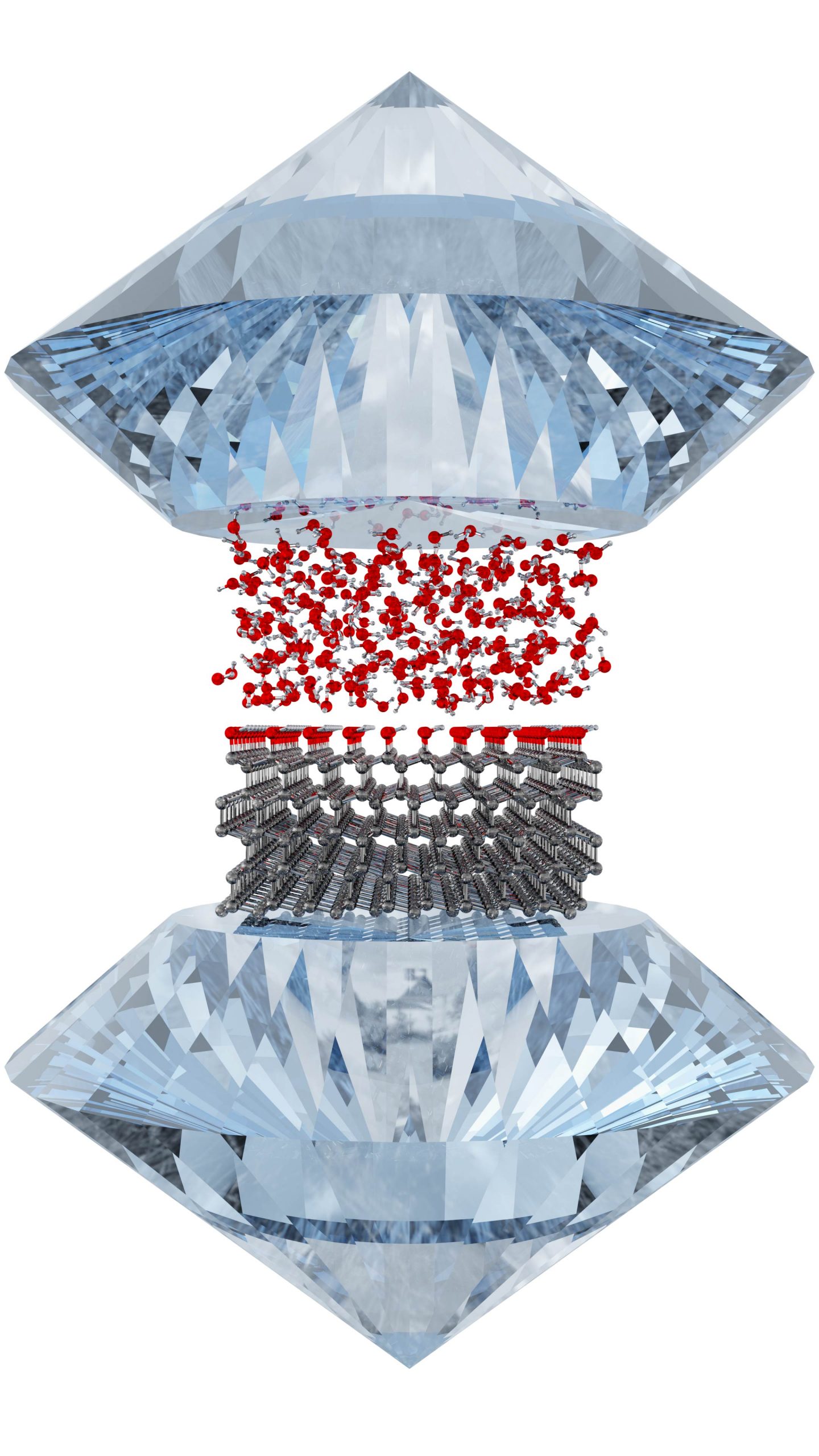 The search for 2D diamond has recently become a trending topic in materials science and condensed matter physics due to the promise of combining bulk diamond’s remarkable properties to new properties that may arise from the reduced dimensionality. Its existence was first proposed over a decade ago and efforts to experimentally obtain 2D diamond are in initial stage. In this brand new and fast-moving field of 2D diamond research, there are two main routes being explored for synthesis: high-pressure compression and chemical functionalization of few-layer graphene. Recent high-pressure experiments provided significant advancements in the field, however, expected properties of a 2D-like diamond such as sp3 content, transparency, and hardness, have not been observed together in a compressed graphene system. In our recent work, we showed for the first time the formation of a hard, transparent sp3-containing 2D phase from few-layer graphene compressed in a water pressure transmitting medium, from several changes in the Raman spectra and optical images upon compression as well as from indentation marks on the SiO2 substrate- a material considerably harder than graphene systems-, as evidenced by atomic force microscopy (AFM) measurements of the samples post-compression. Our theoretical calculations and experimental data indicate a novel, surface-to- bulk phase transition mechanism that gives hint of the formation of diamondene: a 2D ferromagnetic semiconductor with spin-polarized bands.
The search for 2D diamond has recently become a trending topic in materials science and condensed matter physics due to the promise of combining bulk diamond’s remarkable properties to new properties that may arise from the reduced dimensionality. Its existence was first proposed over a decade ago and efforts to experimentally obtain 2D diamond are in initial stage. In this brand new and fast-moving field of 2D diamond research, there are two main routes being explored for synthesis: high-pressure compression and chemical functionalization of few-layer graphene. Recent high-pressure experiments provided significant advancements in the field, however, expected properties of a 2D-like diamond such as sp3 content, transparency, and hardness, have not been observed together in a compressed graphene system. In our recent work, we showed for the first time the formation of a hard, transparent sp3-containing 2D phase from few-layer graphene compressed in a water pressure transmitting medium, from several changes in the Raman spectra and optical images upon compression as well as from indentation marks on the SiO2 substrate- a material considerably harder than graphene systems-, as evidenced by atomic force microscopy (AFM) measurements of the samples post-compression. Our theoretical calculations and experimental data indicate a novel, surface-to- bulk phase transition mechanism that gives hint of the formation of diamondene: a 2D ferromagnetic semiconductor with spin-polarized bands.
See also L. G. Pimenta Martins et al. Hard, transparent, sp3-containing 2D phase formed from few-layer graphene under compression, Carbon 173, 744 (2020)
An advance in x-ray imaging unlocked by randomized light
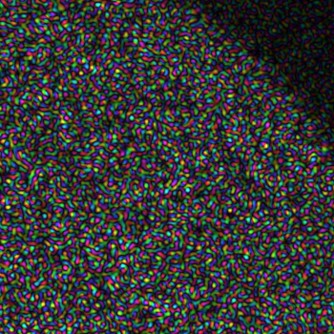 Because many materials – particularly strongly interacting electron systems – are intrinsically heterogeneous at the nanoscale, imaging their properties rather than just measuring an average is increasingly important. A major advance in x-ray imaging has been the introduction of coherent ‘lensless’ microscopy, which has unlocked the ability for researchers to take high-resolution snapshots with x-rays. However, these methods typically require special sample processing steps which are incompatible with many materials, limiting the use of lensless imaging. In our recent work, we show how the use of “band-limited random” light (see figure) enables the fast visualization of extended, unprocessed samples at the nanoscale. This method, termed Randomized Probe Imaging (RPI), can be readily implemented at existing instruments for X-ray microscopy and scanning nanodiffraction experiments. Because of its robustness and ease of implementation, RPI is poised to become a standard part of the x-ray imaging scientist’s toolbox.
Because many materials – particularly strongly interacting electron systems – are intrinsically heterogeneous at the nanoscale, imaging their properties rather than just measuring an average is increasingly important. A major advance in x-ray imaging has been the introduction of coherent ‘lensless’ microscopy, which has unlocked the ability for researchers to take high-resolution snapshots with x-rays. However, these methods typically require special sample processing steps which are incompatible with many materials, limiting the use of lensless imaging. In our recent work, we show how the use of “band-limited random” light (see figure) enables the fast visualization of extended, unprocessed samples at the nanoscale. This method, termed Randomized Probe Imaging (RPI), can be readily implemented at existing instruments for X-ray microscopy and scanning nanodiffraction experiments. Because of its robustness and ease of implementation, RPI is poised to become a standard part of the x-ray imaging scientist’s toolbox.
See also A. Levitan et al. Single-frame far-field diffractive imaging with randomized illumination, Optics Express 28, 37103 (2020)
Electronic bands in an ideal 2D kagome lattice
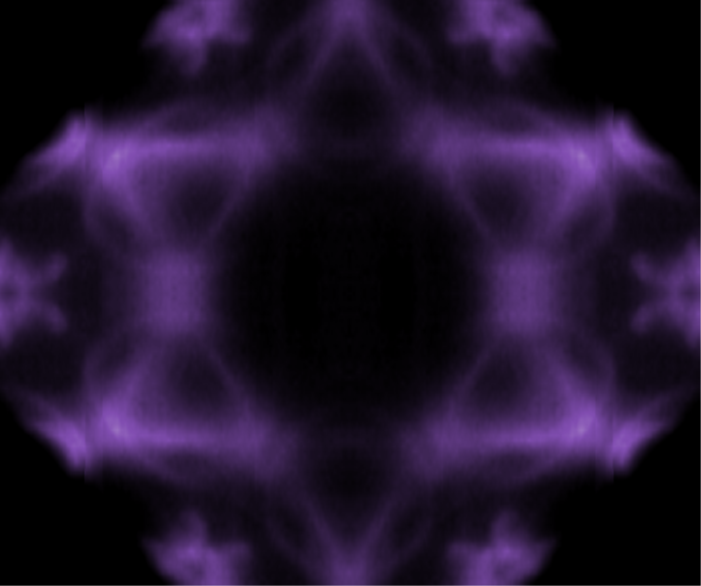 The symmetries of the atomic lattice shape the quantum motion of electrons in solids: the best known example is the emergence of massless Dirac fermions protected by the hexagonal symmetry of graphene. The kagome lattice is a two-dimensional network of corner-sharing triangles resembling the ‘David star’ or ‘Japanese basket weaving’ patterns. The symmetry of the kagome lattice is special, in the sense that it simultaneously harbors infinitely light, massless Dirac fermions and infinitely heavy, dispersionless flat bands. This prototypical electronic structure of the kagome lattice could not be observed for a long time, but we recently found these signatures in single-layer kagome metals FeSn and CoSn. We combined two complementary electronic structure probes: angle-resolved photoemission spectroscopy (ARPES) and de-Haas van Alphen quantum oscillation experiments. In FeSn, our termination-resolved ARPES experiments with a micro-focused beam reveal unexpected surface Dirac electrons on the specific lattice terminations. Such unique and rich two-dimensional electronic states further coexist with room-temperature magnetism in FeSn. In FeSn and CoSn, we further discovered the signatures of the long-sought flat bands, and demonstrated their topological nature in CoSn, as support by a large (80 meV) spin-orbit gap between the Dirac and flat bands. Harnessing the observed electronic and magnetic properties of transition metal-based kagome compounds is an exciting could provide a new basis for novel correlated topological phases and new spintronic devices.
The symmetries of the atomic lattice shape the quantum motion of electrons in solids: the best known example is the emergence of massless Dirac fermions protected by the hexagonal symmetry of graphene. The kagome lattice is a two-dimensional network of corner-sharing triangles resembling the ‘David star’ or ‘Japanese basket weaving’ patterns. The symmetry of the kagome lattice is special, in the sense that it simultaneously harbors infinitely light, massless Dirac fermions and infinitely heavy, dispersionless flat bands. This prototypical electronic structure of the kagome lattice could not be observed for a long time, but we recently found these signatures in single-layer kagome metals FeSn and CoSn. We combined two complementary electronic structure probes: angle-resolved photoemission spectroscopy (ARPES) and de-Haas van Alphen quantum oscillation experiments. In FeSn, our termination-resolved ARPES experiments with a micro-focused beam reveal unexpected surface Dirac electrons on the specific lattice terminations. Such unique and rich two-dimensional electronic states further coexist with room-temperature magnetism in FeSn. In FeSn and CoSn, we further discovered the signatures of the long-sought flat bands, and demonstrated their topological nature in CoSn, as support by a large (80 meV) spin-orbit gap between the Dirac and flat bands. Harnessing the observed electronic and magnetic properties of transition metal-based kagome compounds is an exciting could provide a new basis for novel correlated topological phases and new spintronic devices.
See also M. Kang et al. Dirac fermions and flat bands in the ideal kagome metal FeSn, Nature Materials 19, 163 (2020)
And M. Kang et al. Topological flat bands in frustrated kagome lattice CoSn, Nature Communications 11, 4004 (2020)
In the news: MIT News; ALS Science Highlights
X-ray imaging of magnetic fractals in complex oxides
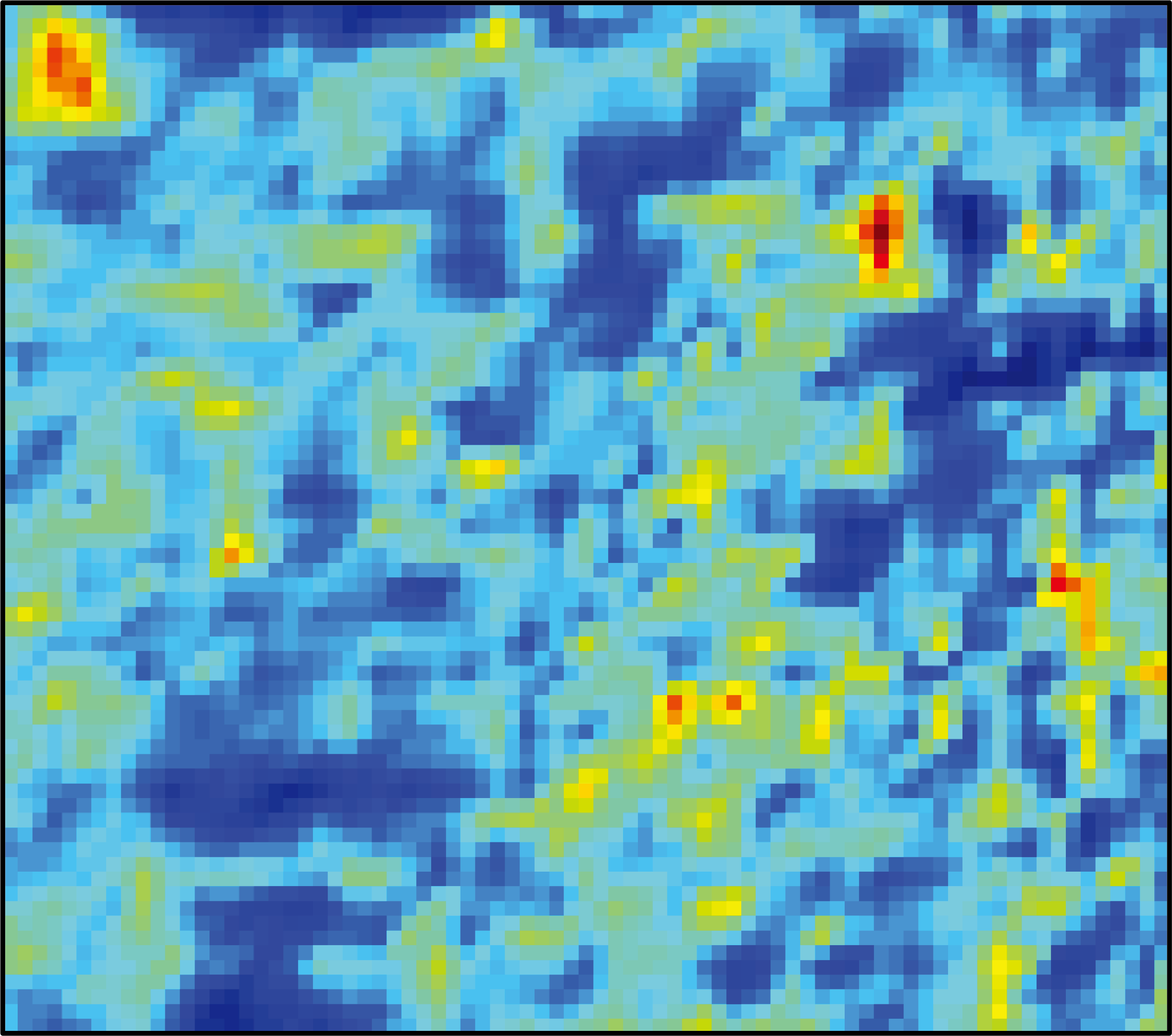 Fractals are mathematical patterns that lack a sense of scale – they look identical at all levels of detail, a characteristic known as self-similarity. As a result, a fractal contour has fundamentally different properties than a line or a curve, and its dimensionality is not a simple integer (1, 2, or 3) as is otherwise prescribed by Euclidean geometry. We report the discovery of nanoscale magnetic fractals in a quantum material that is uniquely proximate to a critical point. To visualize this state, we have used the scanning X-ray nanoscope that can detect (antiferro-)magnetic domain with nanometric precision. By applying this technique to a thin film of the magnetic oxide NdNiO3 (neodymium nickelate), we have observed textures of unique richness spanning multiple spatial scales. Most strikingly, we have found that these magnetic patterns have a fractal nature and are characterized a non-integer dimensionality. Our research suggests that novel functional oxide materials can display a very rich nanoscale structure that is key to understand their unique phenomenology and unlock their potential for future applications in spintronics and neuromorphic computing.
Fractals are mathematical patterns that lack a sense of scale – they look identical at all levels of detail, a characteristic known as self-similarity. As a result, a fractal contour has fundamentally different properties than a line or a curve, and its dimensionality is not a simple integer (1, 2, or 3) as is otherwise prescribed by Euclidean geometry. We report the discovery of nanoscale magnetic fractals in a quantum material that is uniquely proximate to a critical point. To visualize this state, we have used the scanning X-ray nanoscope that can detect (antiferro-)magnetic domain with nanometric precision. By applying this technique to a thin film of the magnetic oxide NdNiO3 (neodymium nickelate), we have observed textures of unique richness spanning multiple spatial scales. Most strikingly, we have found that these magnetic patterns have a fractal nature and are characterized a non-integer dimensionality. Our research suggests that novel functional oxide materials can display a very rich nanoscale structure that is key to understand their unique phenomenology and unlock their potential for future applications in spintronics and neuromorphic computing.
See also J. Li et al. Scale-invariant magnetic textures in the strongly correlated oxide NdNiO3, Nature Communications 10, 4568 (2019)
In the news: MIT News
An electronic glass in lightly electron-doped copper-oxide superconductors
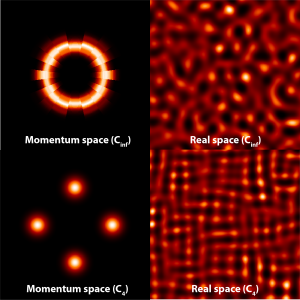 Charge order is a collective ground state of quantum material in which electrons self-organize into a periodic pattern breaking the translational symmetry of lattice. Recent experiments have revealed the charge order phase in cuprate high-temperature superconductors, raising questions on its origin and its relation with superconductivity. Until now, charge order in cuprate has been detected only along Cu-O bond direction (or a, b axes of unit cell) with C4 rotational symmetry in momentum space. In stark contrast, our recent resonant X-ray scattering study on electron-doped (Nd,Pr)2CuO4 has uncovered an unprecedented form of charge order with Cinf rotational symmetry in momentum space. Viewed in real-space, this observation corresponds to a ‘glassy’ short-range order of electrons with well-defined periodicity but without any orientational preference. Our charge susceptibility calculation reveals that this glassy electronic order originates from defect-induced Friedel oscillation under strong antiferromagnetic correlation, highlighting the interplay of spin and charge degrees of freedom in superconducting cuprates.
Charge order is a collective ground state of quantum material in which electrons self-organize into a periodic pattern breaking the translational symmetry of lattice. Recent experiments have revealed the charge order phase in cuprate high-temperature superconductors, raising questions on its origin and its relation with superconductivity. Until now, charge order in cuprate has been detected only along Cu-O bond direction (or a, b axes of unit cell) with C4 rotational symmetry in momentum space. In stark contrast, our recent resonant X-ray scattering study on electron-doped (Nd,Pr)2CuO4 has uncovered an unprecedented form of charge order with Cinf rotational symmetry in momentum space. Viewed in real-space, this observation corresponds to a ‘glassy’ short-range order of electrons with well-defined periodicity but without any orientational preference. Our charge susceptibility calculation reveals that this glassy electronic order originates from defect-induced Friedel oscillation under strong antiferromagnetic correlation, highlighting the interplay of spin and charge degrees of freedom in superconducting cuprates.
See also M. Kang et al. Evolution of charge order topology across a magnetic phase transition in cuprate superconductors, Nature Physics 15, 335-340 (2019)
In the news: MIT News; ALS Science Highlights
Anomalous room temperature antiferromagnetism in ruthenium oxide
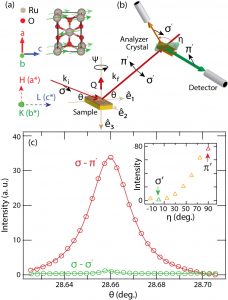 Ruthenium oxide (RuO2) has been extensively used in electrocatalysis owing to its remarkable efficiency and stability. For decades, it has been considered as a Pauli paramagnet, until a recent neutron study on a bulk crystal of RuO2 revealed the presence of itinerant, above-room-temperature antiferromagnetism. We studied the magnetic ordering of thin films and bulk crystals of rutile RuO2 using resonant magnetic x-ray scattering across the Ru-L2 absorption edge. Combining polarization analysis and azimuthal angle dependence of the magnetic Bragg signal, we have established the presence and texture of the collinear antiferromagnetic order in RuO2 with TNeel > 300 K. In addition to revealing a robust antiferromagnetic ground state, the persistence of collinear spin order even in nanometer-thick films paves the way for potential applications of RuO2 in antiferromagnetic spintronic devices.
Ruthenium oxide (RuO2) has been extensively used in electrocatalysis owing to its remarkable efficiency and stability. For decades, it has been considered as a Pauli paramagnet, until a recent neutron study on a bulk crystal of RuO2 revealed the presence of itinerant, above-room-temperature antiferromagnetism. We studied the magnetic ordering of thin films and bulk crystals of rutile RuO2 using resonant magnetic x-ray scattering across the Ru-L2 absorption edge. Combining polarization analysis and azimuthal angle dependence of the magnetic Bragg signal, we have established the presence and texture of the collinear antiferromagnetic order in RuO2 with TNeel > 300 K. In addition to revealing a robust antiferromagnetic ground state, the persistence of collinear spin order even in nanometer-thick films paves the way for potential applications of RuO2 in antiferromagnetic spintronic devices.
See also Z. Zhu et al. Anomalous Antiferromagnetism in Metallic RuO2 Determined by Resonant X-ray Scattering, Physical Review Letters 122, 017202 (2019)
Anomalous Hall physics and Berry curvature in a kagome metal
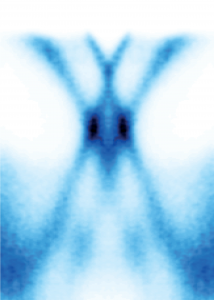 Recent theoretical studies have stimulated interests on kagome lattice as a platform for novel topological physics. In these proposals, the major role is played by topological Dirac and flat bands imposed by the symmetry of kagome plane. Despite of these predictions, the characteristic band structure has avoided experimental observations. Recently, we have successfully observed a pair of two-dimensional Dirac bands in bulk kagome compounds Fe3Sn2 using angle-resolved photoemission spectroscopy. Combined with intrinsic spin-orbit coupling and ferromagnetism, the Dirac bands generates sizable intrinsic anomalous Hall conductivity, observed by our transport measurements over a wide temperature range (0.6 K ~ 400 K). Our results establish the direct link between the band structure and emergent topological transport in the correlated kagome metal.
Recent theoretical studies have stimulated interests on kagome lattice as a platform for novel topological physics. In these proposals, the major role is played by topological Dirac and flat bands imposed by the symmetry of kagome plane. Despite of these predictions, the characteristic band structure has avoided experimental observations. Recently, we have successfully observed a pair of two-dimensional Dirac bands in bulk kagome compounds Fe3Sn2 using angle-resolved photoemission spectroscopy. Combined with intrinsic spin-orbit coupling and ferromagnetism, the Dirac bands generates sizable intrinsic anomalous Hall conductivity, observed by our transport measurements over a wide temperature range (0.6 K ~ 400 K). Our results establish the direct link between the band structure and emergent topological transport in the correlated kagome metal.
See also L. Ye, M. Kang et al., Massive Dirac fermions in a ferromagnetic kagome metal, Nature 555, 638 (2018)
In the news: MIT News, Berkeley Lab, phys.org, Newsweek, BBC

